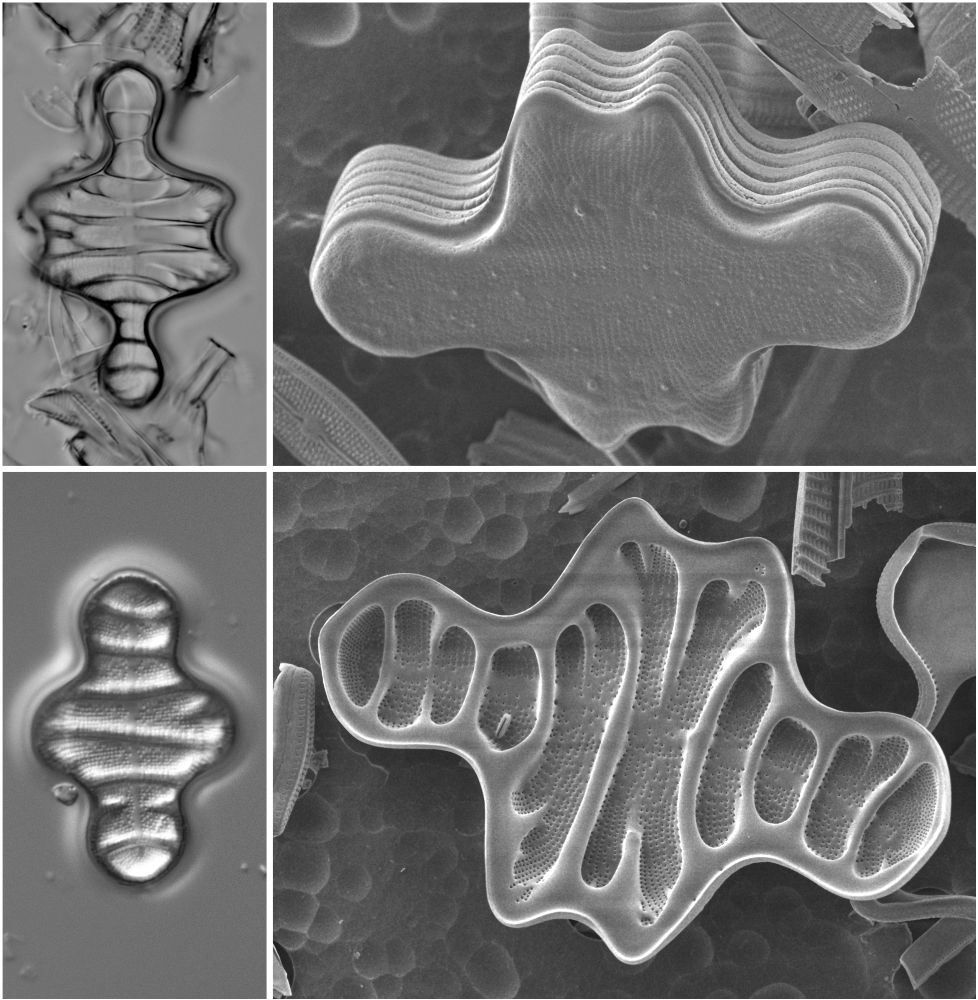Tetracyclus Ralfs; 1843; 105
Key references
Williams D.M. 1987. Observations on the genus Tetracyclus Ralfs (Bacillariophyta) I. Valve and girdle structure of the extant species. British Phycological Journal. 22(4): 383-399.
Morphology
Frustules usually rectangular in girdle view; when mature pervalvar axis exceeding apical axis. Valves isopolar, their surface flat, mantle vertical, margin sharply stepped hyaline lip.
Primary internal transapical ribs present, sometimes with secondary and tertiary ribs. Sternum with indefinite margins, often internally thickened.
Striae parallel to slightly radiate, extending across mantle to projecting hyaline valve margin. Virgae coarser than vimines, raised above valve surface close to margin, becoming less so towards sternum. Areolae close to sternum more widely spaced than elsewhere, and somewhat irregularly distributed.
Apical pore fields present in some species, consisting of demarcated area with striae closely spaced, as are areolae within them. Rimoportulae often present, simple, varying in number and position.
Cingulum consisting of several (many) open bands, opening at alternate poles; others closed. Cingulum composed of four kinds of bands: valvocopula, with septum; primary copulae, each with ligula and septum; secondary copulae, without septa, their ligulae larger than those of primary copulae; single pleura. Septa arising from abvalvar part of pars exterior of valvocopula and primary copulae, extending variable distances into frustule interior; pore situated at or near base of septum, on abvalvar face communicating via groups of pores on outer face of band.
Type species: Tetracyclus glans (Ehrenb.) Mills 1935, p. 1602 = Tetracyclus lacustris Ralfs 1843a, p. 105, pl. 2, fig. 2.
About 35-40 species known, mostly fossil (extinct), with only three living species known from UK and Europe:
Tetracyclus emarginatus (Ehrenb.) W. Smith (Basionym = Biblarium emarginatum Ehrenb.)
Tetracyclus glans (Ehrenb.) F.W. Mills (Basionym = Navicula glans Ehrenb.; synomym: Tetracyclus lacustris Ralfs)
Tetracyclus rupestris (Kützing) Grunow in Van Heurck (Basionym = Denticula thermalis β [var.] (‘rupestris’) rupestre Kützing)
Primary internal transapical ribs present, sometimes with secondary and tertiary ribs. Sternum with indefinite margins, often internally thickened.
Striae parallel to slightly radiate, extending across mantle to projecting hyaline valve margin. Virgae coarser than vimines, raised above valve surface close to margin, becoming less so towards sternum. Areolae close to sternum more widely spaced than elsewhere, and somewhat irregularly distributed.
Apical pore fields present in some species, consisting of demarcated area with striae closely spaced, as are areolae within them. Rimoportulae often present, simple, varying in number and position.
Cingulum consisting of several (many) open bands, opening at alternate poles; others closed. Cingulum composed of four kinds of bands: valvocopula, with septum; primary copulae, each with ligula and septum; secondary copulae, without septa, their ligulae larger than those of primary copulae; single pleura. Septa arising from abvalvar part of pars exterior of valvocopula and primary copulae, extending variable distances into frustule interior; pore situated at or near base of septum, on abvalvar face communicating via groups of pores on outer face of band.
Type species: Tetracyclus glans (Ehrenb.) Mills 1935, p. 1602 = Tetracyclus lacustris Ralfs 1843a, p. 105, pl. 2, fig. 2.
About 35-40 species known, mostly fossil (extinct), with only three living species known from UK and Europe:
Tetracyclus emarginatus (Ehrenb.) W. Smith (Basionym = Biblarium emarginatum Ehrenb.)
Tetracyclus glans (Ehrenb.) F.W. Mills (Basionym = Navicula glans Ehrenb.; synomym: Tetracyclus lacustris Ralfs)
Tetracyclus rupestris (Kützing) Grunow in Van Heurck (Basionym = Denticula thermalis β [var.] (‘rupestris’) rupestre Kützing)
Literature
References are given in chronological order.
Reference |
Citation |
|---|---|
| Williams D.M. 1987. Observations on the genus Tetracyclus Ralfs (Bacillariophyta) I. Valve and girdle structure of the extant species. British Phycological Journal. 22(4): 383-399. | Morphology; Type Illustration; Taxonomy; |
| Williams D.M. 1989. Observations on the genus Tetracyclus Ralfs (Bacillariophyta) II. Morphology and taxonomy of some fossil species previously classified in Stylobiblium Ehrenberg. British Phycological Journal. 24(4): 317-327. | Morphology; Taxonomy; Illustrations |
| Williams D.M. 1990. Examination of auxospore valves in Tetracyclus from fossil specimens and the establishment of their identity. Diatom Research. 5(1): 189-194. | Morphology; Illustrations |
| Williams D.M. & Li J. 1990. Observations on the diatom genus Tetracyclus Ralfs (Bacillariophyta). III. Description of two new species from Chinese fossil deposits. British Phycological Journal. 25(4): 335-338. | Morphology; Taxonomy; Illustrations |
| Williams D.M. 1996. Fossil species of the diatom genus Tetracyclus (Bacillariophyta, 'ellipticus' species group): morphology, interrelationships and the relevance of ontogeny. Philosophical Transactions of the Royal Society B. 351(1348): 1759-1782. | Morphology; Taxonomy; Illustrations |
| Williams D.M. 2007. Paleogeographic impact of a newly described 'cruciform' sub-group of Tetracyclus (Bacillariophyta, Diatomaceae). Micropaleontology. 53(5): 421-429. | Morphology; Taxonomy; Illustrations; Ecology |
| Williams D.M. 2014. The diatom genus Tetracyclus (Fragilariaceae, Bacillariophyta) from Chile. Phytotaxa. 178(2): 151-155. | Morphology; Taxonomy; Illustrations |
| Kelly M.G. 2015. https://microscopesandmonsters.wordpress.com/2015/09/16/a-genuinely-rare-diatom-genus/. | Ecology |
| Williams D.M., Spaulding S.A., Bishop I. 2021. Studies on type material from Kützing's diatom collection IV. The basionym, author and type of Tetracyclus rupestre. Phytotaxa. 498(1): 44-50. | Morphology; Taxonomy; Illustrations |
This page should be cited as:
Williams D. M., Jüttner I., Van de Vijver B. Tetracyclus Ralfs; 1843; 105. In: Jüttner I., Carter C., Cox E.J., Ector L., Jones V., Kelly M.G., Kennedy B., Mann D.G., Turner J. A., Van de Vijver B., Wetzel C.E., Williams D.M..
Freshwater Diatom Flora of Britain and Ireland. Amgueddfa Cymru - National Museum Wales. Available online at https://naturalhistory.museumwales.ac.uk/diatoms/browsespecies.php?-recid=3749. [Accessed:
].
Record last modified: 05/07/2022


